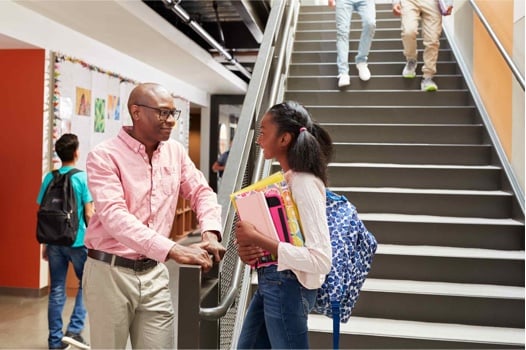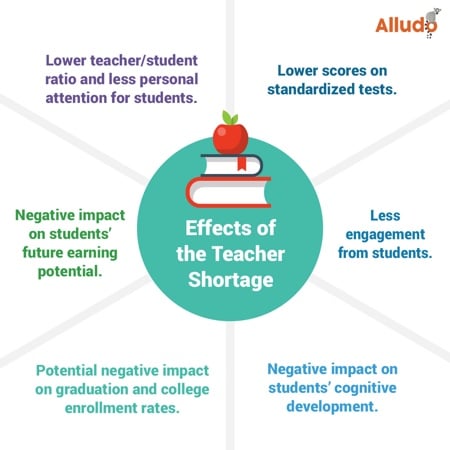Quick Tip Wednesday: How to Set Up a Gratitude Month
Welcome back to Quick Tip Wednesday!
6 min read
Julia Francis : Jan 7, 2022 2:00:00 PM

Education is the key to success in life, and teachers make a lasting impact in the lives of their students. ~ Solomon Ortiz
In every school district, there are issues that administrators must face on an ongoing basis. One of the most important, which has the potential to impact every aspect of education, is teacher retention. Are your teachers happy in their jobs? Will they stay with your district – and your students – in the long run?
At Alludo, we work with administrators every day to help them provide relevant professional learning opportunities to teachers, paraeducators, and administrators at every level. We recognize the challenges that are inherent in the issue of teacher recruitment and teacher retention. We believe that using a learner-centered approach is one of the most effective ways to ensure that your teachers feel happy, supported, and committed to their jobs.
When people talk about teaching as a profession, they often mention its most rewarding aspects, things like getting students excited about what they learn and seeing improvements in standardized test scores and graduation rates. Those things are wonderful – we agree! But there’s a tendency for some to use the best and most rewarding parts of being a teacher as an excuse to ignore the things that are most difficult.
One of the things that the COVID-19 pandemic has done is to crystallize the issues that face people in many professions, including teaching. A Business Insider article from July of 2021 reported on the growing teacher attrition in the United States and examined some of the reasons.
The article cited an NEA survey reporting that 32% of respondents were considering leaving teaching early because of the pandemic. Another study by Frontline Education found that fully two-thirds of American school districts had a shortage of teachers. The pandemic did not start the shortage, which has been worsening for years, but it did exacerbate it.
Some school districts have begun offering signing bonuses and retention bonuses as a way of convincing teachers to stay on the job but that’s a solution that isn’t sustainable unless your district has deep pockets. We believe there’s a better way.
What is causing the teacher shortage? As you might expect, there’s no easy answer – and the same is true of the potential effects of the shortage, which could impact the nation’s students for years to come.
Let’s start with the causes for teacher attrition. According to an NBC report from 2021, the teacher shortage has been steadily worsening since 2010. As of 2019, the nation needed 100,000 more teachers than it had and the pandemic has made that number larger than it was.
The main reasons for the shortage have to do with teacher dissatisfaction in several areas. The most common reason cited for leaving teaching was low pay, which impacted teachers in two significant ways. The first was that 67% had to take a second job to make ends meet, and the second was that many new teachers entered the profession carrying thousands of dollars in student debt.
Economic factors might be the biggest driver of teacher turnover but stress, school climate, and a lack of mentorship and administrative support also play important parts. School districts must take action to ensure that teachers feel supported and valuable, and that includes giving them a voice in professional development.
The effects of the teacher shortage are more troubling than the shortage itself. When there aren’t enough teachers in a school district, the results are undeniable:

We believe that both teacher retention and student outcomes can be positively impacted by the adoption of a learner-centered approach to professional development. When teachers are engaged and excited about teaching, their engagement helps students become more engaged. It also increases student comprehension of complex concepts and ideas, and it reduces the likelihood of any student slipping through the cracks because teachers will have the knowledge and tools to help them.
One of the keys to ending the teacher shortage is figuring out ways for school districts to increase their teacher retention rates. The only way to do that is by making teaching careers desirable by providing the necessary support and mentorship. Here are three ways to address the issue of retention.
/AL_04-Blog02-2.jpeg?width=450&name=AL_04-Blog02-2.jpeg)
Many teachers who leave the profession mention issues with their working environment as a factor. Examples of environmental issues include the following:
Our survey found that 68% of teachers believed their workload was too heavy. We also asked what would better help teachers have an impact on students and the number one response was a more manageable workload (56%).
Admittedly, it is difficult to reduce class sizes when your district is already experiencing a teacher shortage, but that’s something that may be mitigated by hiring classroom assistants and paraeducators to alleviate the burden on teachers.
Teachers at every level require support and mentorship but it’s particularly important for new teachers to receive the support they need. Being certified as a teacher is not enough to give someone the tools they need to connect with students and deliver the best outcomes.
Support can come from peers and administrators and it’s important to encourage peer mentorship in your school district. When we asked what type of professional development is most effective in our Teacher Happiness Survey, 51% of teachers selected collaboration with a colleague. You also need to consider how and when your administrators support teachers.
If you want to improve teacher retention, professional development and educational leadership must be a priority and not an afterthought. Teachers who participate in a learner-centered professional development program are more likely to stay in the profession because they are getting the tools they need to excel at their jobs.
We also asked K-12 teachers what would help them have a better impact on students and the #2 response was participating in professional development that matches their skill level (35%).
You’ll need to make sure that teachers in your district meet their state PD goals, but a robust system of professional learning will go above and beyond the minimum requirements to elevate teachers.
At Alludo, we specialize in creating learner-centered professional development programs for school districts. This approach has been proven to work. Let’s look at the Jurupa Unified School District as an example:
As a result of these features, students and teachers are engaging at rates between 70% and 90%!
Alludo believes that putting teachers and students first leads to success for school districts and administrators. Our approach is unique:
Our approach is one that’s proven to work. The school districts who have partnered with us have seen concrete results, including increased teacher and student engagement, higher teacher retention rates, and higher overall satisfaction among teachers. While we can’t help you end your teacher shortage overnight, we can provide you with a professional learning platform that will reduce teacher turnover and improve your chances of attracting new educators to your district.
Adopting a learner-centered approach to professional development is the best way to keep the teacher workforce in your district satisfied and supported and to reduce the chances that they will leave your district or leave the education field for another profession.
Want to reach up to 100% PD in your district? See how Alludo can help make it happen with our free professional development platform trial, including:
.png)
Welcome back to Quick Tip Wednesday!

Mid-Year Reflection: Your Secret to a Stronger Second Semester
A great way to get your learners engaged in your Alludo program is by keeping the content in your program up-to-date and relevant. Rebecca has...